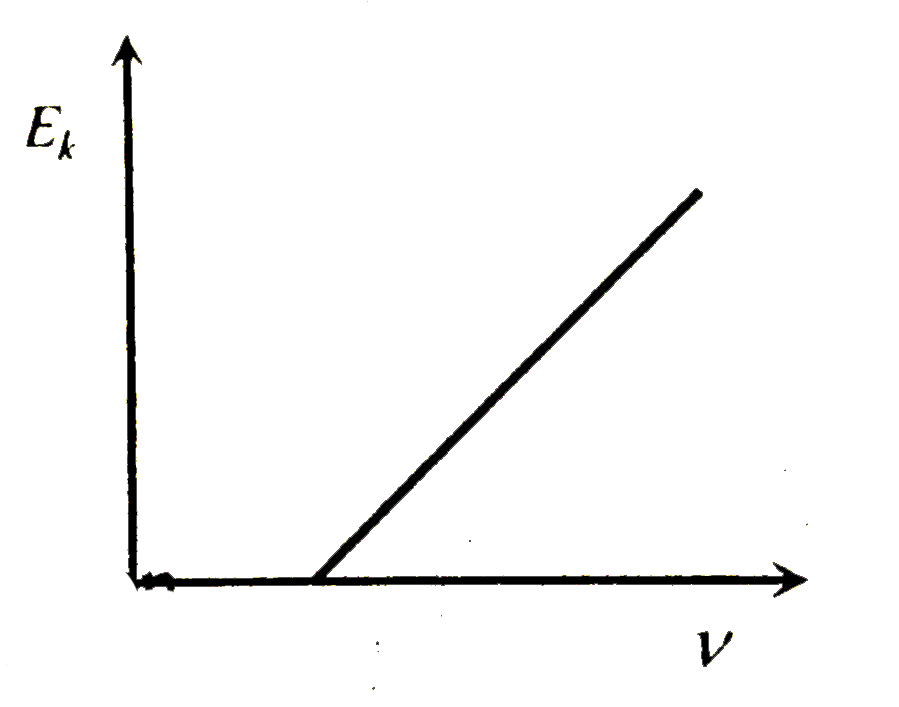Photons with energy 5eV are incident on a cathode C in a photoelectric cell . The maximum energy of emitted photoelectrons is 2eV. When photons of energy 6eV are incident on C , no photoelectrons will reach the anode A , if the stopping potential of A relative to C is
5
3 V
1 V
4 V
The correct Answer is:B
To solve the problem step by step, we will use the concepts of photoelectric effect and stopping potential.
Step 1: Determine the Work Function (Φ)
The maximum kinetic energy (K.E.) of the emitted photoelectrons can be found using the equation:
K.E.=Ephoton−Φ
Where:
- K.E. is the maximum kinetic energy of the emitted photoelectrons,
- Ephoton is the energy of the incident photons,
- Φ is the work function of the cathode.
From the problem, we know:
- Ephoton=5eV
- K.E.=2eV
Substituting the values into the equation:
2eV=5eV−Φ
Rearranging gives:
Φ=5eV−2eV=3eV
Step 2: Analyze the Situation with 6 eV Photons
Now, when photons of energy 6eV are incident on the cathode, we need to find the stopping potential Vs such that no photoelectrons reach the anode.
The maximum kinetic energy of the photoelectrons when 6eV photons are incident can be calculated as:
K.E.=Ephoton−Φ
Where:
- Ephoton=6eV
Substituting the values:
K.E.=6eV−3eV=3eV
Step 3: Relate Kinetic Energy to Stopping Potential
The stopping potential Vs is related to the maximum kinetic energy by the equation:
K.E.=e⋅Vs
Where e is the charge of an electron (1 eV corresponds to 1 volt of stopping potential).
Substituting the maximum kinetic energy:
3eV=e⋅Vs
Thus,
Vs=3V
Conclusion
The stopping potential of the anode A relative to the cathode C is:
Vs=3V
Final Answer
The stopping potential of A relative to C is 3 V.
---
The maximum kinetic energy (K.E.) of the emitted photoelectrons can be found using the equation:
K.E.=Ephoton−Φ
Where:
- K.E. is the maximum kinetic energy of the emitted photoelectrons,
- Ephoton is the energy of the incident photons,
- Φ is the work function of the cathode.
- Ephoton=5eV
- K.E.=2eV
2eV=5eV−Φ
Φ=5eV−2eV=3eV
Now, when photons of energy 6eV are incident on the cathode, we need to find the stopping potential Vs such that no photoelectrons reach the anode.
K.E.=Ephoton−Φ
Where:
- Ephoton=6eV
K.E.=6eV−3eV=3eV
The stopping potential Vs is related to the maximum kinetic energy by the equation:
K.E.=e⋅Vs
Where e is the charge of an electron (1 eV corresponds to 1 volt of stopping potential).
3eV=e⋅Vs
Thus,
Vs=3V
The stopping potential of the anode A relative to the cathode C is:
Vs=3V
The stopping potential of A relative to C is 3 V.
Topper's Solved these Questions
- MODERN PHYSICSBOOK - DC PANDEY ENGLISHCHAPTER - MODERN PHYSICSEXERCISE - for JEE Advanced (only one option is Correct)
76 Videos
- MODERN PHYSICSBOOK - DC PANDEY ENGLISHCHAPTER - MODERN PHYSICSEXERCISE - for JEE Advanced (More than One Options is Correct )
1 Videos
- MAGNETISM AND MATTERBOOK - DC PANDEY ENGLISHCHAPTER - MAGNETISM AND MATTEREXERCISE - Medical gallery
1 Videos
- MODERN PHYSICS - 1BOOK - DC PANDEY ENGLISHCHAPTER - MODERN PHYSICS - 1EXERCISE - Level 2 Subjective
23 Videos
Similar Questions
The maximum kinetic energy of a photoelectron is 3 eV. What is its stopping potential ?
View SolutionA photon of energy 3.3 eV , find the momentum of photon is
View SolutionPhotons of energy 6eV are incident on a metal surface whose work function is 4eV. The minimum kinetic energy of the emitted photo - electrons will be
View SolutionThe maximum kinetic energy of photoelectrons emitted from a surface when photons of energy 6eV fall on it is 4eV . The stopping potential , in volt is
View SolutionLight of wavelength 4000A∘ is incident on a metal surface. The maximum kinetic energy of emitted photoelectron is 2 eV. What is the work function of the metal surface?
View SolutionWhat is the wavelength of a photon of energy 1 eV?
View SolutionLight of wavelength 3000Å is incident on a metal surface whose work function is 1 eV. The maximum velocity of emitted photoelectron will be
View SolutionFind frequency of a photon of energy 3.3 eV?
View SolutionA photon of energy 15eV collides with H−atom. Due to this collision, H−atom gets ionized. The maximum kinetic energy of emitted elecrtron is:
View SolutionFor the photoelectric effect, the maximum kinetic energy Ek of the emitted photoelectrons is plotted against the frequency of the incident photons as shown in the figure. The slope of the curve gives

View Solution
